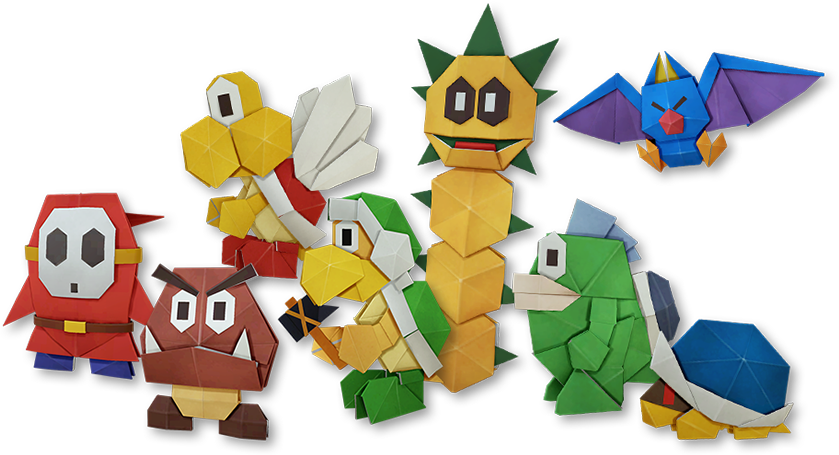

Its turn-based gameplay using well-timed jumps and hammer swings will be a familiar sight for Paper Mario purists, while the addition of a grid layout to rotate and shuffle enemies into more manageable groups adds a fun new puzzle layer. The Origami King's battle system is a good example of all this. The Origami King does offer a few welcome concessions to its RPG roots, but it also shies away from growing these further over the course of the game, struggling to ever emerge truly distinct. As more of The Origami King emerged during its remarkably short route to reveal and then release, Paper Mario fans (and particularly those of hallowed GameCube entry The Thousand-Year Door) desperately tried to pigeonhole this latest incarnation as one thing or another - adventure or RPG? - to determine the kind of experience it might offer. For many, this tussle goes beyond simple genre preference - it is central to Paper Mario's premise, and to its ability to present Mario's worlds and characters in a way only this series, which comes around rarely, is able to provide. Paper Mario: The Origami King reviewīut Paper Mario has also experienced a tug of war between its adventuring and role-playing mechanics, with recent entries opting to fold away their RPG gameplay and keep it tucked out of sight. Happily, you'll find much of the same heart, humour and character once again in The Origami King. Within its creases and corrugated backdrops, Paper Mario has consistently shaped the Mushroom Kingdom and its inhabitants into something more textured and weighty than its materials might ever suggest. In its cardboard castles and papercraft dioramas, Paper Mario's mix of adventuring and role-playing has always managed to showcase Mario's surroundings as more than just background scenery, spotlight sidekicks or rivals and make them more than just one-dimensional, and be that rarest of things for video games - frequently very funny. There's always been something unique in Paper Mario's wafer thin worlds: a sense of place and personality, an ability to linger and explore, a chance to stop and befriend.

#PAPER MARIO THE ORIGAMI KING FULL#
Here’s how that went.Nintendo sketches another warm and colourful Paper Mario adventure, though never traces its full potential. So, on the 17th, when the game dropped I sat down with my kids next to me and popped it in. Now, as a parent, I could introduce Mario to my two kids, including my six-year-old who is obsessed with origami and can create elaborate shapes that make my brain pretzel trying to understand. This is the first console Paper Mario game to drop since I had kids. When Paper Mario: The Origami King came out, I was excited for a new reason. I stared at this moment for like five minutes. You really don’t realize how good the graphics are until the jarring moment where you see an actual rock in contrast to everything.

And with modern graphics, they bring this to a new level. In one game, Mario could actually fold himself into a paper airplane, allowing him to glide across large gaps. A construct as simple as a paper fan could send a community blowing away like flower petals. A character could be hiding between wood beams merely by turning sideways. This lead to a lot of cool, creative ideas. Not only did the characters of this universe look like paper, but they WERE also paper and absolutely self-aware of this fact.Ĭase in point, this Toad that was folded in half that decided it wanted to make my four-year-old scream. Paper Mario was a lot more forgiving of an RPG and, thanks to its adorable aesthetic of making everyone look like moving paper, it opened a lot of avenues for cool visual effects and ideas. It was Mario’s second attempt at making RPGs after Super Mario RPG: The Legend of the Seven Stars for the Super Nintendo.


 0 kommentar(er)
0 kommentar(er)
